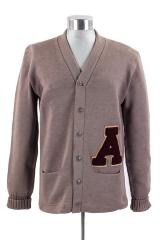Comments and Tags
Be the first to comment on this item!
Clothing and Accessories ➔ Ensemble
Identifier:
2022.112.1Description:
The dress is a traditional Mexican Ballet Folklorico Chiapaneco dress from the region of Chiapas. The dress is original in origin: a silk blouse, circular and off the shoulder with a flounce of embroidered flowers from the region. The skirt, also silk, has flounces of flowers embroidered from the region. The four-piece ensemble also contains an underskirt and a crinoline made of netting for added fullness. It was purchased by Francisco Vega in Mexico for his daughter Margaret Vega for the first Grand Rapids Hispanic Festival held in 1969.Date:
circa 1967Materials:
Silk, Embroidery Thread, NettingCurrent Location Status:
On ExhibitCollection Tier:
Tier 2Source:
Gift of Margaret VegaExhibits/Programs:
Fashion + Nature (April 2022)Fashion + Nature examines the relationships between the natural world and the fashion industry. Clothing has long been produced with natural materials and inspired by the beauty and diversity of the natural world, but the fashion industry has had a largely negative impact on the environment. This exhibit showcases a wide variety of captivating scientific specimens and fascinating garments, to illustrate their relationship to each other and their interconnected histories. Fashion + Nature aims to inspire and educate visitors, encouraging us to become better consumers and reduce the harmful impacts of the fashion industry.
Sister cities ()
Related Entities:
Margaret Vega (donor)Margaret Vega is a Professor of Undergraduate and Graduate Painting at Kendall College of Art and Design and the Founding Director of SiteStudio and Children Designing for Children Project. Vega previously taught Accademia di Belle Arti, Perugia, Italy and Grand Valley State University, MI. An accomplished artist, Vega has worked on many major exhibitions including: 14th Annual Juried Show, Prince Street Gallery, NYC, GeoLogic, Juried Show, Atlantic Gallery NYC; and Medina Gallery, Selected Group Exhibition, Rome, Italy and is featured locally in permanent exhibits at Grand Rapids Art Museum and Frederik Meijer Gardens Museum and Sculpture Park. The Grand Rapids Public Museum featured Vega's work in the exhibition Celebration of Souls: Day of the Dead in Southern Mexico (2022). Vega created a candlelit alter, known as an ofrenda honoring her father, Francisco Vega (1922-2021). Francisco was a leader in the Latino community of West Michigan and a grassroots organizer for civil rights. Francisco Vega (is related to)
Francisco Vega (1922 - 2021) was born to Mexican American parents in San Antonio, Texas before moving to Grand Rapids, Michigan where he became a leader in the West Michigan Hispanic community. After attending a military high school he enlisted at 17 with the US Army, and was promoted to an elite team as a decoder for his typing speed. He was awarded a bronze star and numerous medals for actions in some of World War II major battles including the D-Day Invasion on Omaha Beach and the Battle of the Bulge.
After the war, he married Phyllis Jean Lackland and they had three daughters, Margaret, Liz and Susan. A lifelong entrepreneur and business consultant, Vega attended University of Michigan and graduated from Aquinas College with a degree in Business. He was the founder of several organizations that served the Hispanic community and notably, co-organized the first Hispanic festival and parade in 1968. In 1955, he taught himself to draft and designed the first privately owned cemetery in the Midwest open to all people regardless of race or religion.
He worked with national labor leaders Cesar E. Chavez and Dolores Huerta in the late 1960's and remained passionate about equality throughout his life. A respected figure nationally, he frequently traveled to the White House, advising Presidents Kennedy, Nixon, Reagan, Ford and Bush, Sr. He was an international advisor and US representative to Prime Minister Price of British Honduras following their independence. He held many appointed and elected positions including Board Member of SER Jobs for Progress in Dallas, Texas. Vega was elected Midwest Vice Chairman of the Republican National Hispanic Assembly and promoted the responsibility to vote by organizing numerous community register to vote campaigns.
Among his many accomplishments, Vega was a national pioneer of bilingual education and in 1977 was the co-founder of the National Hispanic Scholarship Fund, the largest Hispanic scholarship fund to date. He left a legacy here in Grand Rapids through his mentoring of start up Latino businesses, chair of the first Ethnic Heritage Celebration at the Museum, and had an instrumental role in the development of Millennium Park and the renaming of Hall Street School and Grandville Avenue to honor Cesar E. Chavez.
